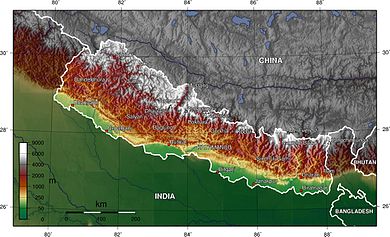
Nepal’s Multidimensional Diplomatic Strategy
Nepal’s geostrategic position, nestled between China and India and influenced by global powers like the United States, requires a nuanced approach to preserve sovereignty and neutrality in a multipolar world.
To navigate this complex landscape, Nepal must adopt a proactive, balanced, and institutionalized strategy rooted in pragmatic diplomacy and economic resilience.
First, Nepal’s diplomacy must anchor itself in geographic realism. Landlocked between India and China, Nepal’s survival depends on balancing relations with both giants while avoiding overdependence. This is akin to a small boat navigating between two tidal waves—leaning too close to one risks capsizing. Notably, scientific studies of power asymmetry (e.g., game theory) show smaller states thrive by diversifying partnerships, leveraging neutrality, and acting as a bridge, not a battleground.
The second pillar is economic pragmatism. Nepal’s GDP relies on remittances (approximately 23.1% of GDP) and agriculture, both vulnerable to external shocks. Therefore, diplomacy must prioritize trade diversification, hydropower exports, and tourism—sectors proven to stabilize economies. Just as ecosystems need biodiversity to withstand disasters, Nepal’s economy needs multiple revenue streams. For instance, data from landlocked nations like Bhutan show energy exports (e.g., hydropower to India) can reduce fiscal fragility.
Equally urgent is climate-adaptive diplomacy. Nepal contributes 0.1% to global emissions but faces glacial melt, floods, and landslides. Consequently, diplomacy must frame Nepal as a climate frontline state to secure international funds, including the UN’s Green Climate Fund. Scientifically speaking, linking Himalayan ecology to global food/water security (rivers feeding 1 billion people) creates moral and practical leverage, akin to a fire alarm that demands collective action.
Furthermore, Nepal needs to amplify its diplomatic volume through neighborhood-first trust-building. A prime example is “hydropower diplomacy” with India and China—selling energy to both, avoiding zero-sum deals, which can bring these Asian giants to common ground for mutual cooperation. Such an approach holds massive potential to develop joint infrastructure projects like cross-border grids, reducing tensions as seen in the EU’s coal-steel integration post-WWII.
Simultaneously, soft power cultivation can bolster Nepal’s influence. By exporting cultural capital—Buddhist and Hindu heritages, and the Gurkha legacy—Nepal can attract tourism and investment, mirroring Thailand’s “Land of Smiles” strategy. For example, Lumbini, the birthplace of Lord Buddha and the Pashupatinath Temple serve as transnational cultural assets, fostering goodwill with Buddhist-majority states and Hindu-majority India.
Meanwhile, the Gurkha legacy projects soft power through associations with bravery and UN peacekeeping, enhancing Nepal’s global image. Together, these tools create solidarity, aiding Nepal’s strategic autonomy, much like Switzerland’s neutrality branding.
To strengthen its position, Nepal should promote data-driven negotiations. By deploying GIS mapping for border disputes or climate data to demand funds, Nepal can shift from emotional appeals to evidence-based dialogue. This strategy mirrors Singapore’s use of facts to “punch above its weight,” transforming Nepal into a “smart negotiator.”
Additionally, youth-centric diplomacy is critical. With 40% of its population under 30, Nepal can invest in STEM education and global fellowships to cultivate skilled diplomats and entrepreneurs. For instance, youth delegations at UN forums project a progressive image, countering stereotypes of Nepal as “backward.” Similarly, empowering young entrepreneurs through cross-border grants builds networks akin to Rwanda’s post-genocide youth-driven rebranding.
To achieve tangible results, Nepal must prioritize human capital. This involves strengthening STEM education, expanding healthcare, and aligning vocational training with economic needs. By adopting Germany’s apprenticeship model and incentivizing green startups, Nepal can retain talent and boost GDP. Crucially, gender equity in education and labor can unlock further growth, transforming youth from a burden into engines of prosperity.
Ultimately, Nepal’s diplomacy must function like adaptive organisms in nature, evolving through flexibility and resilience. For example, strict non-alignment allows Nepal to navigate India-China tensions like an octopus blending into environments. Similarly, symbiotic trade relationships—exporting hydropower while importing technology—mirror mutualism in ecosystems. Time-sensitive actions, such as climate advocacy and learning from Singapore or Costa Rica, are vital, as delays risk irreversible losses.
Hence, Nepal should codify neutrality into law, ensuring consistency across political cycles. By anchoring non-alignment in its constitution—akin to Switzerland’s model—Nepal can build trust, deter interference, and emerge as a calm, principled actor in a turbulent world. Just as roots stabilize a tree, this legal backbone will shield Nepal from geopolitical storms, securing its sovereignty for generations